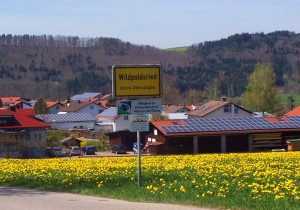By Christie Allen – Bio Cycle
Wildpoldsried produces 321 percent more energy than it needs and is generating $5.7 million in annual revenue — a remarkable accomplishment for a modest farming community that has been able to invest in new municipal infrastructure without going into debt.
In 1997, when the newly elected Mayor and Village Council of Wildpoldsried, Germany took their posts, everyone agreed that its goals should be to build new industry, keep initiatives local, bring in new revenues and create no debt. Those goals included construction of a new sports hall, theater stage, pub, and retirement house. Without going into debt, the mayor and council assumed it would take several decades to achieve. But clever thinking, a national policy that “paid back” on investments in renewable energy and a community-supported vision of environmental and economic stewardship, have led to fulfilling those goals in significantly less time. This article tells the story of Wildpoldsried, a small agricultural village in the state of Bavaria, which serves as a model of how to achieve community sustainability in the 21st century — and remain debt-free.
[pro_ad_display_adzone id=”110028″]
In May 2011, 14 years later, Mayor Arno Zengerle announced at a town hall meeting that it’s “half time” of his third term. He walked the community through a massive list of accomplishments that include nine new community buildings (including the school, gym and community hall) complete with solar panels, four biogas digesters with a fifth in construction, seven windmills with two more on the way, 190 private households equipped with solar, a district heating network with 42 connections, three small hydro power plants, ecological flood control and a natural wastewater system. Wildpoldsried (pop. <2,600) now produces 321 percent more energy than it needs and is generating 4.0 million Euro (US $5.7 million) in annual revenue. This is a remarkable accomplishment for a modest farming community that turned a village with no industry into an industry of renewable energy with the help of local entrepreneurs and pioneers. Small businesses have sprung up to sell and install technologies and provide services to the renewable energy installations — from solar panels to district heating to the anaerobic digesters and energy efficiency retrofits.
WIND AND BIOGAS ENERGY
In 1999, the Village Council crafted a mission statement — WIR–2020, ‘Wildpoldsried Innovativ Richtungsweisend (Wildpoldsried Innovative Leadership) — which became the blueprint for how it should consider its citizens’ demands, community projects and future development and growth. In turn, the council hoped that the guidelines would inspire people to get involved, begin thinking greener and create jobs and businesses for the community. The W.I.R – 2020 focused on three main themes: 1) Renewable Energy and Saving Energy; 2) Ecological Construction of Buildings Using Ecological Building Materials (mainly wood-based); and 3) Protection of Water and Water Resources (both above and below ground) and Ecological Disposal of Wastewater.
One citizen, Wendelin Einsiedler, started talking to his neighbors and friends about the community’s direction, resulting in the formation of a civic society. At the time, he wasn’t sure where things were headed but wanted the society to be an active group that could lead the way for the new initiatives in Wildpoldsried. In 1999, the society established EW Wind Energy GmbH Hutoi to build two Enercon E-58 community windmills to produce 3.5 MWh of power. The total investment was 4.4 million Deutsch-marks (DM), comprised of 25 percent equity and about 70 percent debt and a small grant from the state of Bavaria (200,000 DM) specifically allocated for testing the two Enercon E-58 wind turbines. (The value of a DM in 1999 was about 1.95 Euros €.)
In June 2001 the society created a second company, EW Wind Energy GmbH & Co.KG Haarberg, which had 94 investors. Each investor could contribute a minimum of 5,000 € up to 25,000 €. Two windmills were constructed, producing 4.5 MWh. The total investment was 6.6 million DM, 2.5 million DM in equity and 4.5 million debt. In June 2008, a fifth windmill was installed to produce an additional 4.0 MWh, bringing total installed capacity to 12 MWh. Most recently, in May 2011, Einsiedler raised funds for a third company to install two more windmills. This investment is only available to the citizens of Wildpoldsried. The two new windmills will each have a capacity of 2.3 MW. Overall, investors in the society’s community windmill projects have been receiving a minimum of an 8 to 10 percent return on their investments, says Einsiedler.
Not long after Einsiedler received approval for the society’s first pair of windmills in April 2000, his brother Ignaz Einsiedler went to the village council for approval to build a second biogas plant on his dairy farm. The first biogas plant became operational in 1997. Two other biogas plants are operating on village dairy farms. Today, three biogas companies are operating four anaerobic digesters that produce a total of 320,000 kWh/year. “One-by-one, individuals came forward with ideas and plans to become energy independent,” says Susi Vogl, council administrator.
NATURAL WASTEWATER TREATMENT PLANT
Even before the village council crafted a mission statement, many people were already thinking greener. As a pilot project in the fall of 1994, the third generation owner of Schellheimer, a local landscape company, built the first private natural wastewater system for his home. At the time, flooding was a big issue in Wildpoldsried and it was a constant concern for the citizens.
In 2000, Mayor Zengerle secured a European Union grant that focused on flood control and rainwater diversion. In the Mayor’s mind, the project could be more comprehensive by including a natural wastewater system for the entire community utilizing wetlands that could release clean water into the local stream. Schellheimer was approached to design a pilot project.
The system was designed similarly to a conventional wastewater plant, with three simple processes: a sedimentation tank, a (plant) filtration system and clarifier for sludge removal. WiWaLaMoor (the name of the natural wetlands) was designed for optimal drainage with two rectangular-shaped, lined humification beds, in order to achieve a steady accumulation of humus. It was estimated that in 7 to 10 years, 100 m3 of humus could be harvested from the process and thereafter 20 m3 of monthly harvesting was available. Schellheimer uses the humus for customers’ landscaping orders.
The first two years of the project were difficult. “The problem was that our existing clarification plant was obsolete and didn’t have any chemical or additional cleaning layer,” explains Gà¼nter Mögele, a member of the Village Council. “We were not sure whether we would get permission from the regional water authority again to operate it. That permission has to be renewed every 20 years. Together with the pilot system from Schellheimer, our permission was renewed. If this hadn’t worked, we would have had to build a totally new and very expensive wastewater plant or pump our waste-water to a central plant in another village, which would have required construction of many kilometers of pipes.”
After the WiWaLaMoor pilot program was completed in 2006, the council approved full-scale production of the natural wetlands. Involved in the process were the Water Authority of Kempten and the District offices of the Oberallgà¤u Health Department, measuring the water treatment with soil tests and other parameters set by both organizations. The project also took into account flooding of the stream (the Leubas), which occurred during the rainy season in the Allgà¤u. Today, says Vogl, “we are supporting 2,570 residents’ wastewater with natural wetlands and we haven’t had any more trouble.”
Wildpoldsried has built a trail with informational stations to explain its WiWaLaMoor project. “Water is life for everyone and it is evident that the ecological interplay between people and their environment must be sustainable.” explains Mayor Zengerle. The nature trail includes a honey bee friendly garden complete with a hive, two natural ponds, an orchard with 96 fruit trees and the natural wetlands park, which is now thriving with dragonflies, birds, butterflies and plants.
Wildpoldsried has a central composting collection facility for yard trimmings and landscaping waste. It opened after aggressive regional recycling programs were enacted when the village’s landfill closed many years ago. Additional laws were enacted that required residents with yards to compost their yard trimmings and food scraps (no meat, bread and dairy) at home. Households without yards put their organics in the trash, which is hauled to a regional incinerator.
BOOST FROM FEED-IN TARIFF
The momentum for renewable energy really picked up after Germany introduced a new feed-in tariff under the Renewable Energy Source Act of 2000 (the Erneneurbare-Energien-Gesetz, or EEG). The EEG made it economically viable for citizens, small businesses and entrepreneurs to get into the renewable energy business, especially solar. “By 2004, more people started to invest in solar,” says Vogl. “The Mayor started asking more citizens to place panels on their roofs. Even I installed solar panels on my house because the feed-in tariff contract was guaranteed. I went to the bank, opened a line of credit and bought my panels. They will be paid off in a few more years from the revenue I have been receiving from the power company.”
How the structure works is based on the type of alternative energy produced. For example, homeowners in Wildpoldsried who installed solar in 2004 were guaranteed to receive 45.7 to 57.4 cents/kWh (based on kWh production). AàœW, the regional power company, must purchase the energy (with a guaranteed constant price for 20 years). The extra costs that utilities incur for feed-in tariff payments are averaged across the country, and then recovered through an equal surcharge placed on electricity bills. In the region of the Allgà¤u, where Wildpoldsried is located, the AàœW reports that household energy prices have increased from .1608 € cents/kWh in 1999 to .2575 € cents/kWh in 2011. About 14 percent of that increase is attributed to the EEG.
“Homes with solar pay the same price as everybody, but in the new EEG law from 2011, the energy company has to pay 12 cents for every kWh homeowners use from their solar panels,” explains Councilman Mögele. “This means homeowners with solar panels save the .2575 € cents and receive .1200 € cents on top, leaving .3775 € cents in their pocket. If you use more than 30 percent of your self-produced energy by yourself, you receive €16 cents.”
Today, over 190 households in Wildpoldsried have solar panels producing 3300 kWp (p = peak, or maximum potential); nine municipal buildings are producing 390 kWp. Energy generated from these buildings is sold to AàœW; the revenue covers the cost of annual maintenance. Any additional profits fund community needs such as musical instruments for the schools and new equipment for the volunteer fire department.
DISTRICT HEATING, ENERGY EFFICIENCY
In 1999, the first evaluation of a district heating system in Wildpoldsried found it was not viable because a network needed to be laid first and the location of the heating system needed to be centralized. The project was delayed for four years until a new community hall had been erected in the village square. Wildpoldsried applied for a grant in February 2005 to install a CHP system in the basement of the community hall and a heating network under the street. In November 2005, a biomass (wood pellet) heating system was put into operation and the old oil heaters in the community buildings were retired.
Many new buildings have been erected or remodeled in Wildpoldsried in the past 16 years, and it was recommended that wood be used as building material or an energy source. The fact that the village is surrounded by 1,413 hectares of forest meant wood was a locally available and renewable resource, and generates revenue for the local tree farmers. “For our central heating system, we only use pellets, which are industrially produced in Bavaria mainly out of waste wood from the wood industry,” says Mögele. “Some home heating systems use wood chips (‘Hackschnitzel’) out of the local forests made mostly from waste wood like branches.”
In terms of energy efficiency, Wildpoldsried follows the Passive House program created by the German federal government under a 2008 resolution from the European Parliament. In 2011, the Wildpoldsried Village Council adopted an ordinance that requires all new home construction to incorporate energy efficiency measures, similar to those included in the government’s Passive House program. This is the only regulation that Wildpoldsried put into effect since the start of the WIR-2020 program in 1999. Developers of new homes are required to build a passive home, which is defined as having maximum insulation, energy efficient appliances and no oil heaters. The council also established a rebate for new home construction to offset costs of building a “zero energy” home. “With the rebate, Wildpoldsried will pay new homeowners 15 euro/m2 toward the cost of the land if they construct an energy passive house,” explains Mögele.
Remodeled homes are required to undergo a thermal scanning to identify where energy and heat are wasted. From the Passive House consult, the homeowner is required to make improvements during the remodel due to energy inefficiencies. New windows, insulation improvements and replacing oil heaters are all typical recommendations from the energy consultation.
Saving energy has been such a hot topic in the last few years in Wildpoldsried that more pioneering homeowners like Thomas Herring are stepping forward. Herring participated in another energy program called “AlpEnergie Project,” which uses a new technology called Joonior. An appliance is plugged into a Joonior, which monitors the AàœW’s pricing broadcast and turns on the appliance when the price of energy is cheap, thus lowering the cost of consumption.
FUTURE PLANS AND MILESTONES
During the second hour of the May 2011 town hall meeting, Mayor Zengerle laid out the next steps of Wildpoldsried’s sustainable community plan: Participation in Project IRENE (Integration of Renewable Energy and Electric Vehicles) , which includes a Siemens Smart Grid, 37 eCars and a solar charging facility; Expansion of the district heating system and use of LED street lights; and Completion of Wildpoldsried’s new hotel that is attached to the already completed culture café, community hall and education center. The facilities will be used to hold renewable energy seminars and introduce “Eco-Energy Tourism.”
Wildpoldsried was chosen by the Federal Ministry of Economics for Project IRENE because of its renewables portfolio. The study is a joint research program with two universities and AàœW. The project begins in the fall of 2011 and will continue for two years. The study “…will reflect actual patterns of mobility and the mobile batteries in everyday scenarios,” explains Dr. Michael Fiedeldey, Managing Director of the AàœW Kempten. “The main requirement of the study was to find a community that is already producing energy through renewable means. Wildpoldsried was selected because it already generates significantly more renewable energy than consumed.”
AàœW’s network will need to be optimized as a shift occurs from a centralized power supply to a decentralized model, i.e., renewable power supply. In late May 2011, the German government announced it was phasing out all of Germany’s 17 nuclear reactors — eight of which are offline — by 2022 and expanding use of renewable resources. The move was spurred on by the disaster at Japan’s Fukushima nuclear power plant and public opposition to the country’s reliance on nuclear energy. AàœW relies on nuclear energy for 17.1 percent of its power supply; the State of Bavaria, however, gets 63 percent of its power supply from nuclear energy.
When wind and solar farms are in full production, the electrical grid can become overloaded with renewable power. This is currently the case with AàœW, which would like to avoid a costly expansion and restructuring of its network by coordinating the supply, consumption and storage of energy through smart grid technology in combination with electric cars. (A “smart grid” attempts to predict and intelligently respond to consumption patterns of all electric users connected to it, ultimately optimizing power supply and energy efficiencies.) In addition, AàœW wants to reduce the operational and maintenance costs of regional power plants that will be slowing down in production as more local suppliers come online. “The Siemen’s system is not in use yet, but in the second phase of this study we will demonstrate the functionality and practicality of smart grids,” adds Fiedeldey.
“…We are really honored to be selected for this study,” says Mögele. “Energy cannot be destroyed; you must move it, store it or change it. We have already run into problems where we are producing too much renewable energy. It’s very important to make the network intelligent and combine it with a storage system.” He adds that the Village Council is entertaining a second research project with the Fraunhofer Institute for Wind and Energy Systems to convert excess energy to biogas. The concept will take water and C02 to produce methane. “The stored methane will then be saved and converted back to power at a later time,” Mögele explains.
Article Source
BioCycle August 2011, Vol. 52, No. 8, p. 37
About the Author
Christie Allen is the International Sales and Business Development Manager for SUMA GmbH and SUMA America Inc., a biogas mixer and agitation manufacturer. She has over 15 years of experience in technology and business consulting, and volunteers in Wildpoldsried to give Energy Tours in English.
[pro_ad_display_adzone id=”110027″]







